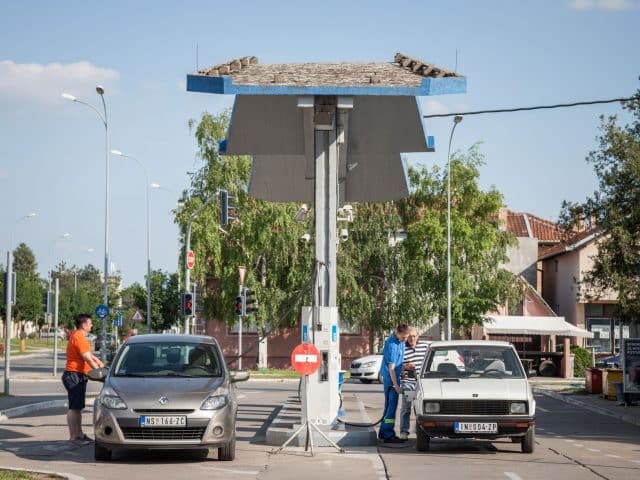Authentix deploys a fuel authentication program to help Serbia recover millions in lost excise taxes
-
Government fuel excise revenues for 2014 were almost USD $161M higher than in 2013
-
Fuel excise tax collections increased by more than USD $23M in just one year
Challenge
 The Republic of Serbia, a country of over seven million people, is located at the crossroads of central and southern Europe and is a transit point for many important commodities traveling from Europe to a wide variety of destinations. In 2009, Serbia’s economy was struggling and a decrease in fuel excise taxes was exacerbating the problem. Serbia’s government noticed that, while the number of fuel stations and the number of vehicle registrations were both increasing, the taxable sale of fuels used in cars was, at the same time, declining. This alerted officials that fuel fraud, intended to facilitate evasion of excise taxes, was an issue that needed to be addressed.
The Republic of Serbia, a country of over seven million people, is located at the crossroads of central and southern Europe and is a transit point for many important commodities traveling from Europe to a wide variety of destinations. In 2009, Serbia’s economy was struggling and a decrease in fuel excise taxes was exacerbating the problem. Serbia’s government noticed that, while the number of fuel stations and the number of vehicle registrations were both increasing, the taxable sale of fuels used in cars was, at the same time, declining. This alerted officials that fuel fraud, intended to facilitate evasion of excise taxes, was an issue that needed to be addressed.
By 2013, 1,434,000 tons of diesel had been consumed in Serbia, while only 902,000 tons had been sold by oil companies through wholesale channels. This left a staggering 37 percent of volume unaccounted for— equating to a tax value of about USD 246,749,850.
The government of Serbia determined that this disparity could be explained by the practice of two illicit trade patterns:
- Direct revenue losses: In this case, fuel to be transported is purposely under-measured by manipulation of measurement equipment and falsification of transport documentation. The unaccounted-for fuel is then diverted to the black market.
- Indirect revenue losses caused by fuel being adulterated and sold at lower costs. This practice was harmful beyond the excise tax losses, as the introduction of adulterants degraded fuel quality—resulting in lower fuel efficiency, harm to the environment, and damage to vehicles and equipment
Solution
PILOT PROGRAM
Prior to the Serbian government implementation of a national fuel authentication solution, a pilot program was initiated to test the suitability of the fuel marker provided by Authentix. The pilot program proved that the marker did not have any adverse effect on fuel properties, homogenized well with the fuel, and the detection technology was easy to use. Most importantly, it demonstrated that the marker made it possible to detect unmarked (i.e., illegal) fuel, and the marked fuel was effectively quantified in the field.
PROGRAM ROLLOUT
As the actual program rolled out, regular sampling and testing begun. This included both field testing at petrol stations, internal stations, depots, and refineries, to indicate the presence of illicit fuel; and laboratory testing to confirm the field results.
MARKERS & DEVICES
The Authentix marker chosen for the program is constructed of the same molecular components as the fuel—making it virtually impossible to separate from the fuel once it has been marked and enabling a level of testing that supports successful criminal prosecution. The marking of both petrol and diesel is done manually at the bulk tank level at eight locations, at the auto truck level at four locations, and at the rail truck level at four locations.
The marking of LPG is done manually at 15 locations. Rapid fuel testing at retail outlets and other bulk storage locations uses Authentix’s LSX and LPX technology, which allows inspectors to quickly screen all retail fuel stations and immediately determine whether the retail fuel has been diluted.
Government officials may then choose to act based on the results from Authentix LSX 2000 and LPX1000 devices (specifically in cases of repeated failed tests over a period), and/or send samples for laboratory testing with our MSX1000 and HPLC devices.
Outcome
In just the first five months of the fuel authentication program, nearly 1 billion liters of fuel were marked, and the Serbian government began to see significant evidence that the program was working— even before enforcement started. Sales volume increased 18% for diesel, 14% for gasoline. And excise revenues increased by over USD $39M when compared to the same period the year before.
- Fuel excise tax collections in February-March 2014 increased by more than USD $23M over the same period in 2013
- It was reported on national television that government fuel excise revenues for 2014 were almost USD $161M higher than the year before
- The number of failed samples at retail outlets has decreased steadily and is now 75% lower than at the start of the fuel marking program.
- Volumes of marked fuel have increased by about seven percent, resulting in significantly increased inflows from paid excises to Serbian government coffer
- From 2013 to 2018, the inflow of funds from the collection of excise taxes on petrol and diesel into the Serbian budget increased by about USD $232M
- From 2013 to 2016, consumption of diesel fuels increased by 30%
